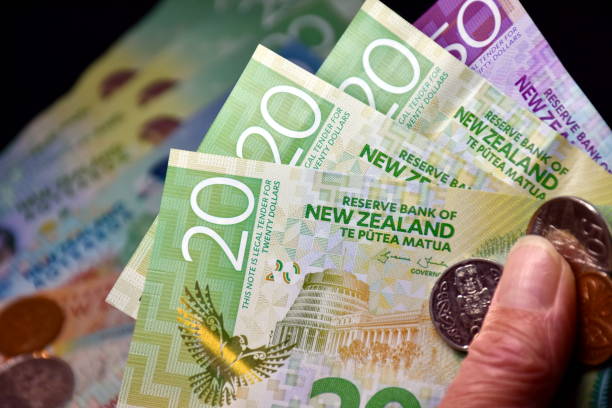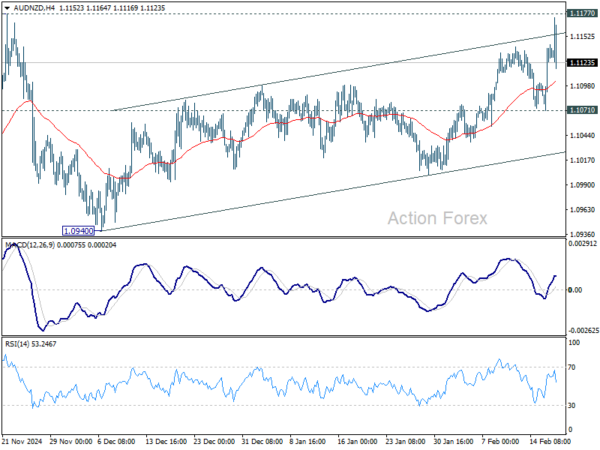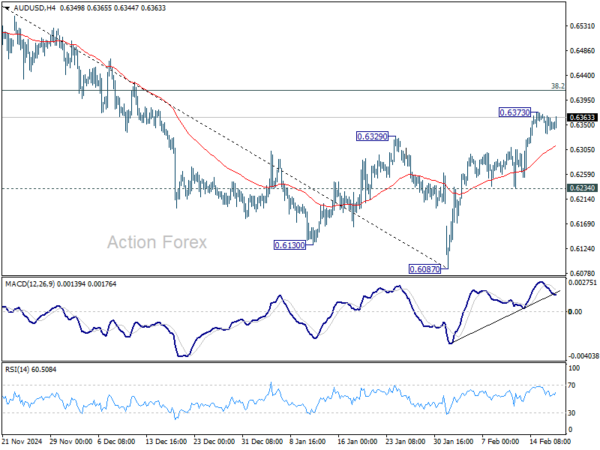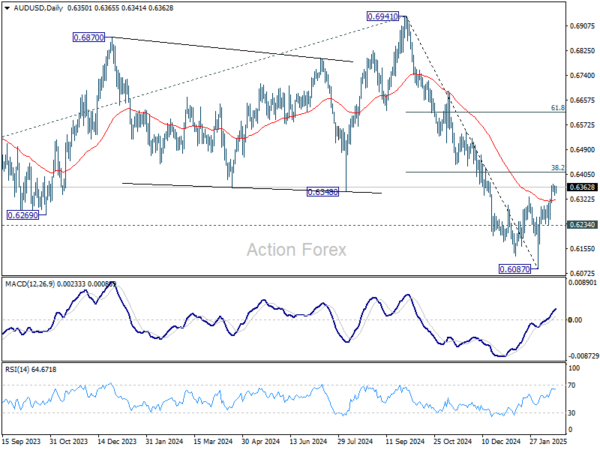New Zealand Dollar initially weakened following RBNZ’s 50bps rate cut today, but quickly regained ground as Governor Adrian Orr indicated that the pace of easing will slow in the coming months. Orr suggested that the central bank is likely to implement just more 25bps cuts, in April and May, provided that economic conditions unfold as expected. However, the Kiwi’s upside remains limited, as RBNZ revised its terminal rate forecast downward to 3.1% by year-end, slightly below November’s projection of 3.2%.
Technically, we’d maintain the view that AUD/NZD’s choppy rise from 1.0940 is a corrective move. So upside should be limited by 1.1177 resistance to bring near term reversal. Break of 1.1071 support will argue that the pattern from 1.1177 has started the third leg, and should decline towards 1.0940 support next.
Outside of NZD-driven moves, the broader forex market remains subdued, with a lack of major catalysts. Dollar is the weakest performer of the day so far, as the momentum from this week’s recovery has faded. Traders are now looking ahead to FOMC minutes, though they are unlikely to provide new insights, instead reaffirming that Fed remains cautious and in no hurry to cut rates again.
British Pound is also under pressure, ranking as the second weakest currency, as investors await the release of UK CPI data. A hot inflation print could diminish expectations for a consecutive BoE rate cut in March, potentially offering some relief to the currency. Swiss franc rounds out the three weakest performers, showing broad softness.
On the stronger side, New Zealand Dollar leads the market. Yen follows, benefiting from continued speculation over future BoJ policy hikes, while the Australian Dollar also holds firm. Euro and Canadian Dollar are positioning in the middle.
In Asia, at the time of writing, Nikkei is down -0.38%. Hong Kong HSI is down -0.28%. China Shanghai SSE is up 0.54%. Singapore Strait Times is up 0.11%. Japan 10-year JGB yield is up 0.002 at 1.439. Overnight, DOW rose 0.02%. S&P 500 rose 0.24%. NASDAQ rose 0.07%. 10-year yield rose 0.072 to 4.544.
RBNZ cuts by 50bps, signals further easing through 2025
RBNZ cut the Official Cash Rate (OCR) by 50bps to 3.75%, as widely expected, while maintaining a clear easing bias.
The central bank stated that “if economic conditions continue to evolve as projected, the Committee has scope to lower the OCR further through 2025.” According to the latest projections, the OCR is expected to decline to 3.1% by year-end and remain at that level until early 2028.
RBNZ acknowledged that economic activity remains subdued, though it expects growth to recover in 2025, driven by lower interest rates encouraging spending. However, elevated global economic uncertainty is likely to weigh on business investment. The bank also noted that inflation is expected to be volatile in the near term, influenced by a weaker exchange rate and higher petrol prices.
Regarding global risks, the RBNZ flagged concerns and warned that higher global tariffs could slow growth in key trading partners, dampening demand for New Zealand exports and weakening domestic economic momentum over the medium term.
However, the impact on inflation is “ambiguous”, depending on factors such as trade diversion, supply-chain adjustments, and financial market reactions.
Australian wages growth slow 0.7% qoq, pressures easing
Australia’s wage price index rose 0.7% qoq in Q4, marking a slowdown from 0.9% qoq and missing expectations of 0.8% qoq. This matches the lowest quarterly growth since March 2022, reinforcing signs that wage pressures are easing, albeit still elevated.
On an annual basis, wages increased 3.2% yoy, making it the slowest pace since Q3 2022. Private sector wage growth came in at 3.3% yoy, the weakest since Q2 2022. Public sector wages rose 2.8% yoy, falling below 3% for the first time since Q2 2023.
BoJ’s Takata: Gradual policy shifts should continue beyond January hike
BoJ Board Member Hajime Takata emphasized the need for the central bank to continue to “implement gear shifts gradually, even after the additional rate hike decided in January 2025”, to mitigate the risk of rising prices and financial market overheating.
Takata noted in a speech today that as “positive corporate behavior” persists, BoJ should consider a “further gear shift” in policy.
He highlighted three key risks that could drive prices above BoJ’s baseline scenario: a stronger wage-price cycle, inflationary pressures from domestic factors, and market volatility, especially in the exchange rates, stemming from a recovery in the US economy.
Nevertheless, due to uncertainties surrounding the US economy and the challenge of identifying the neutral interest rate, Takata advocated for a “vigilant approach”.
Japan’s trade deficit widens as imports surge, exports to China drop
Japan’s trade deficit expanded sharply in January, reaching JPY -2.759T, the largest shortfall in two years, as imports surged 16.7% yoy, far exceeding the expected 9.3% yoy gain.
Meanwhile, exports rose 7.2% yoy, falling slightly short of the 7.7% yoy forecast, with strong shipments to the U.S. (+18.1% yoy) offset by a -6.2% yoy decline in exports to China.
On a seasonally adjusted basis, exports declined -2.0% mom to JPY 9.253T, while imports climbed 4.7% mom to JPY 10.109T, leading to a JPY -857B trade deficit.
Looking ahead
UK CPI is the main focus in European session. EUrozone will release current account. Later in the day, main focus is on FOMC minutes while US will also publish building permits and housing starts.
AUD/USD Daily Report
Daily Pivots: (S1) 0.6335; (P) 0.6352; (R1) 0.6368; More...
Intraday bias in AUD/USD stays neutral for consolidations below 0.6373 temporary top. Rebound from 0.6087 is seen as a correction to the fall from 0.6941. In case of another rise, upside should be limited by 38.2% retracement of 0.6941 to 0.6087 at 0.6413. On the downside, break of 0.6234 support will suggest that the rebound has completed as a correction, and turn bias back to the downside for retesting 0.6087 low. Nevertheless, sustained break of 0.6413, will pave the way back to 61.8% retracement at 0.6615.
In the bigger picture, fall from 0.6941 (2024 high) is seen as part of the down trend from 0.8006 (2021 high). Next medium term target is 61.8% projection of 0.8006 to 0.6169 from 0.6941 at 0.5806. In any case, outlook will stay bearish as long as 55 W EMA (now at 0.6504) holds.



